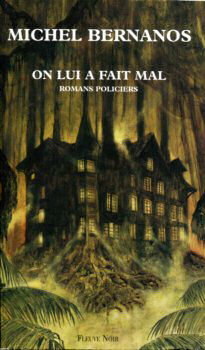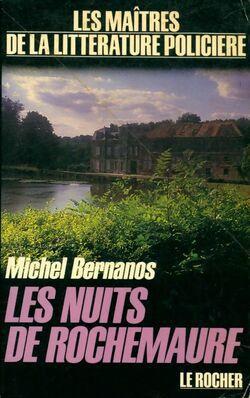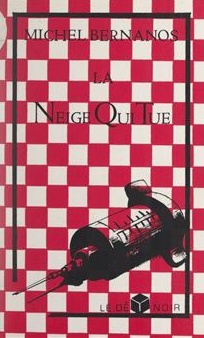Publishers classify these novels as detective stories. However, the author combines the detective story with the fantastic, mixed with Gothic, angst and adventure.
So the reader is confronted with a series of revenge-hungry murderers who seek justice for external events of which they themselves are sometimes the victims (La neige qui tue, On lui a fait mal), but also large, gloomy family homes in which the walls harbor many mysteries (Les nuits de Rochemaure, La Grande Bauche, Le mort veille). In some cases, these homes are the scene of real Machiavellian plans, orchestrated by elements that escape the reader’s notice, and admirably held together by the author’s sense of intrigue.
As in fantasy novels, the descriptions are so real that we are actually living the story!
Thus, in the heart of the Amazon rainforest, we witness the explosion of a drug-trafficking factory, only to find ourselves in the underground of a spooky mansion on French soil, searching for the next secret code that will allow us to get out alive! Each character becomes a potential suspect, and only by analyzing their personalities can we find the killer. Provided, of course, that there is one…
Various themes are tackled: the ravages wrought on human beings by hard drugs and the ensuing trafficking (La neige qui tue), greed in the face of the true meaning of human life (Le mort veille, La Grande Bauche), the post-traumatic syndrome of soldiers returning from war (On lui a fait mal) or the obvious gap between the institutions’ sense of justice and its true meaning.

On lui a fait mal
Jean Savrot. Taken prisoner in ’40, aged seventeen. Escaped in ’43. Joined the Free French Forces. Landed with the 2nd D.B. Heroic conduct, several decorations. Fluent in German. Assigned several missions in East Germany by the intelligence services. Reported missing in ’47. During a mission.
We find Jean Savrot murdered in a Paris apartment decades later. However, witnesses see the same man emerge from the building with a slow, determined stride just after the murder… New murders follow. Inspector Vincent and Inspector Ribault are at a loss, and the investigation is proving long and complex: two people with the same identity, or the presence of a man who, even in death, continues to kill?
The assassin is described as having a sad look in his eyes, and wanders the streets with the sole aim of killing three people with specific names, without even taking the time to eat. He tries to rest as much as possible in the sewers, in contact with the rats. Paradoxically, this character is endearing, and is the very title of the novel.
What remains to be discovered is his identity and the reasons that drive him to kill…
La Grande Bauche
The first thing I noticed was the angle of the roof. The slate-colored house stood out against the pale sky, giving off an indefinable impression of unease. Nonetheless, I continued to climb the hard path to the top, where I could see before me, in all its sadness, the manor house of La Grande Bauche.
One manor house alone seems to carry the malaise of a family going back generations. The manoir de La Grande Bauche is completely surrounded by marshland, in a region where rain and fog reign supreme.
Claude de la Passerelle follows the death of his aunt, who was known to have been particularly bad throughout her life. It was against this backdrop that he invited his closest friends and cousins to spend a few days at the family home. The house is indeed peculiar, and despite her death, the embittered aunt remains omnipresent. She converts her estate into gold coins and decides to hide them in a secret place in the house. As stated in her will, whoever discovers them will be the one to dispose of them.
Unsolved murders ensue, and everyone is scared to death. But that’s not all! Arrows shoot out of the paintings, knives from the ceiling, and the walls make a noise… footsteps can be heard, as if someone were having fun walking through them. This is how our characters discover the existence of a house parallel to the manor house of La Grande Bauche. You just have to find the codes to get there. The manor is a veritable gruyère, crammed with secret passages, each more horrible than the last, and difficult to get out of.
The treasure may be there, but will greed get the better of our protagonists? What will be the priority? Finding the treasure or the murderer? That said, the risk of being murdered in turn remains …
Le Mort Veille
The sensation of cold that suddenly gripped him from head to toe woke him with a start. For a moment, he stood motionless, his eyes open in the dark. From outside, through the garnet-red curtains and thick granite walls, he could hear the storm and the dull roll of thunder. It’s coming in from the moors,” he thought, “the junk farm is going to take another hell of a beating; just like ten years ago, when the great Petronille died from a single stroke of lightning. Real vampire weather on the loose!”
Suddenly, he thought he heard a slight noise in the vast chamber. At the same time, the storm redoubled its efforts, shattering the windows. He wanted to rise. But he couldn’t. A strange force prevented him. He panicked, struggled, tried in vain to get a sound out of his constricted throat. All the while, the pressure holding him to his bed grew stronger and stronger. He suddenly realized that there was nothing he could do about this terrible nightmare. He was going to die. It was all going to be over. He let out a sob and surrendered to hideous fear.
The old Uncle du Maroué, a large family home lost in the middle of the curious Fénétrange forest, drew his last breath. With no posterity and a particularly macabre personality, he took care to draw up a will beforehand, requiring all those intending to succeed him to meet at his home for a few days, and forbidding them to leave the premises, on pain of disinheriting the entire group. However, Maroué is not a common dwelling… A strange figure moves in after dark and never ceases to spill blood after his passage… Everyone fears for their lives, but, bound by the promised reward, they wouldn’t leave the dwelling for anything in the world.
How far will this Machiavellian plan take them?

Les nuits de Rochemaure
Lying on her back, she trembles with fear. To muffle the violent shaking of her body, she clasps her forearms tightly between her sweaty thighs. Her fetal position doesn’t prevent her from hearing the staircase groan. In a final revolt against the fear that paralyzes her, she rejects the blanket covering her face. Her body slowly relaxes, and her anxiety-filled eyes turn to the slowly opening door…
Clotilde moves into the family home of her husband, the Professor Stanislas Durville. The Manoir of Rochemaure, cold, dark and too mysterious for her taste, is very isolated. Clotilde doesn’t like it, and neither do her staff. Her husband, busy with his scientific research, has little time for her, and she feels terribly alone.
Someone is out to get her, she can feel it, she knows it! But who? And how far could this thing go? Her husband doesn’t understand her fears, so she decides to call on her cousin Richard to stay by her side for a few days and, why not, help her unravel the many mysteries surrounding her.

La Neige qui tue
Selected for the French “Prix du Quai des Orfèvres” 1964
Distant music in a dark tunnel… Meadows where the grass is blue… A light that seems green… And then suddenly, an excruciating pain rising from the depths of her being… A stream of hot breath with a faint taste of blood… She’s still breathing. People talk, people live around her, but she knows she’s not quite with them anymore. The fear of the pain that remains there, lurking deep inside her, ready to rise again, pursues her in the midst of her dreams. She vomits bile as sour as death […].
She’ll scream, she screams! But no matter how much she screams her pain, no one will give her the white powder that would enable her to ride her superb golden steed.
Lorris’s sister, a police commissioner, succumbs to a cocaine overdose caused by the dreadful Tinant, head baron of a Brazilian drug cartel. So he decides to take a few days off for a visit. He’s going after him, he’s going to get him! However, unable to avoid collateral damage, he finds himself wanted by the police. Commissaire Bornand investigates, but one detail disturbs him: the man’s modus operandi doesn’t match the personality of his friend Lorris. Yet the man looks exactly like Lorris.
Is it really Lorris? Will this mysterious man be able to avenge the girl’s murder before the police find him?
